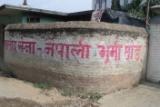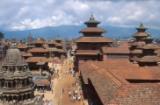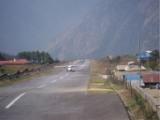Archives
INDIA - NEPAL TIES
There is a groundswell of unhappiness among the Nepalese against India that the India baiters have launched campaigns like the “Bharati Sena Nepali Sima Chhodo (Indian Army Leave Our Borders)”.
The authorities in India would dismiss such instances with eloquent argument. “True to the approach of a visionary leadership in the region, New Delhi always believes that India-Nepal economic cooperation is guided by the conviction that the welfare of the people of India and Nepal is interlinked,” says an official in Delhi.
When Nepal began its journey towards development and prosperity in the 1950s, India was the first country to respond to its quest for cooperation and extended help.
 This bond has sustained over the decades notwithstanding obstacles and limitations. True to this spirit runs a memorable comment from the late legendary Nepali leader and a former Prime Minister, G P Koirala that, “Governments come and go, but the relationship between Nepal and India remains unchanged.”
This bond has sustained over the decades notwithstanding obstacles and limitations. True to this spirit runs a memorable comment from the late legendary Nepali leader and a former Prime Minister, G P Koirala that, “Governments come and go, but the relationship between Nepal and India remains unchanged.”
However, those who interact with common Nepali citizenry at Kathmandu including the likes of street side vendors, the taxi drivers and merchants at Tamel market, there are generally few takers among the Nepalis for the theory of ‘economic cooperation’ for shared benefits.
“People of Nepal may like Indian people but the same cannot be said about the government in Delhi,” summed up a small time trader recently.
A tourist to Nepal at Bhaktpur temple complex, about 30 km from Kathmandu, was angrily received by locals who alleged that “India ne a sab kuchch kha gaya (India has taken away everything from us)”.
But what is significant to note is that even the Nepali political class and intelligentsia harbour reasons for unhappiness against New Delhi.
Close on the heels of the unprecedented Dantewade attack by Naxals, an angry columnist wrote in a Kathmandu-based English daily that “By their own high-sounding admission, the Indians helped end violence in Nepal by prodding the Maoists into the peaceful mainstream. Why can’t those who can bring peace in other countries do the same in their own societies?”
 This was a veiled attack on India’s alleged political interferences in Nepal. A former Nepali foreign minister Upendra Yadav too had echoed similar sentiments.
This was a veiled attack on India’s alleged political interferences in Nepal. A former Nepali foreign minister Upendra Yadav too had echoed similar sentiments.
However, India has been pursuing its cherished strategy of ‘development cooperation’ in South Asia. The refrain is economy, commerce and trade moved global relations today.
Ideologies do not matter much in a world where the underlined emphasis is for a better living condition for the common people and mutual progress in either country. It has increasingly been proved by nations that economic interests can be pursued unhindered by political and diplomatic differences.
This is exactly being worked out by India and Nepal in the recent past.
INDIA FUNDED PROJECTS:
India in recent times chalked out elaborate plans to invest a whopping RS 5600 crore in Nepali currency for various developmental projects to create an ideal model for ‘development cooperation’.
A cursory look at the list of Indian-assisted projects includes the likes of 100-bed Nepal Bharat Maitri Bakhtawari Hari Eye Hospital at Krishnanagar, Kapilivastu at an estimated cost of 100 million Nepali rupees, Manmohan Memorial Polytechnic at Biratnagar, Nepal-Bharat Polytechnic at Hetauda, New Jalpaiguri-Kakarbhitta rail link, Jogbani-Biratnagar Rail Link and a host of feeder roads ensuring much needed connectivity.
 On the railway links, there are five points to be opened with an estimated cost of Rs 2123 crore in Nepali currency. Officials are jubilant to observe that the construction of these cross border railway links would facilitate the movement of passenger and goods traffic.
On the railway links, there are five points to be opened with an estimated cost of Rs 2123 crore in Nepali currency. Officials are jubilant to observe that the construction of these cross border railway links would facilitate the movement of passenger and goods traffic.
A Memorandum of Understanding, signed during the occasion also covered an air services agreement – which among other things sought to allow services to and from another 21 cities in India to any point in Nepal. Nepal is linked to India through an 1800 km open border. Therefore, as economic and physical interconnectivity increase, it will be only natural for India and Nepal to reinforce and expand the bridges that connect people in all realms.
Sources say that Nepal’s main exports to India are textiles at 7.7 per cent, zinc sheet 6.8 per cent, threads, polyester, ready-made garments, juice and other semi-processed and processed food products while imports from India include petroleum products (25.2 per cent), motor vehicles and spare parts, machinery spares, medicines, cold rolled sheets etc.
Nepal has an installed capacity of 630 MW of power of which around 570MW is generated from hydro power though the country is said to have an estimated potential of 83,000 MW of hydro power. Kathmandu is already a favourite destination for several Indian hydroelectric power generation companies including Satluj Jal Vidyut Nigam Ltd, Bhilwara Energy Ltd and GMR Infrastructure Ltd.
It is significant to note that even on the trade front, in the recent past; a corrective measure has been taken by both sides in the form of the revised Trade Treaty signed on October 27, 2009 which envisages that all forms of non-tariff barriers on Nepali exports to India be removed. Billed as a landmark treaty, signed during Indian Commerce Minister Anand Sharma’s visit, the revised agreement will not only add a new dimension in Indo-Nepal relations, but will also reduce huge trade deficit of Nepal with India and also increase the access of Nepalese products to India.
There are still miles to go, they say as Nepali politics is still peculiarly tilted between India-bashing and pro-India blocks. There are some adverse impacts due to such a complexity. Tourism entrepreneurs in Nepal are worried by the recent drop in Indian tourist arrivals in the Himalayan country as Indians account for around 30 per cent of the total number of foreign tourists who visit Nepal by air. Significantly, the number of Chinese tourists for this year has been encouraging with the incoming number recording a big leap of 135 per cent.

